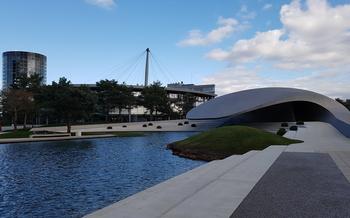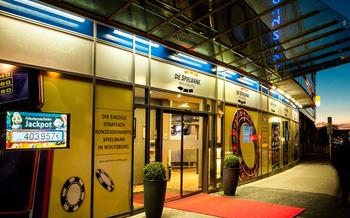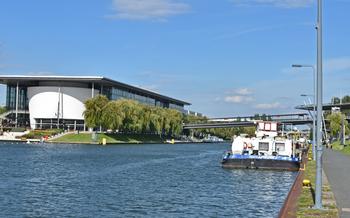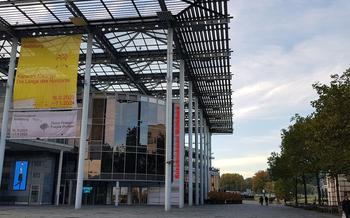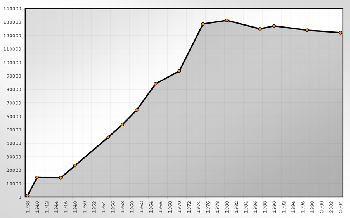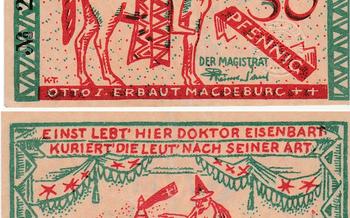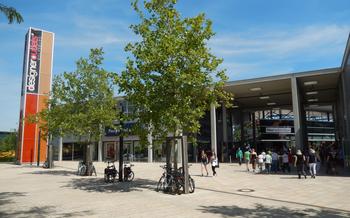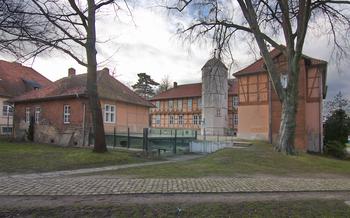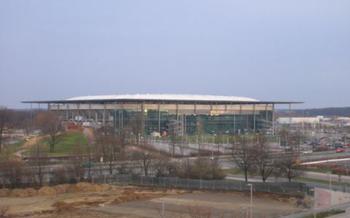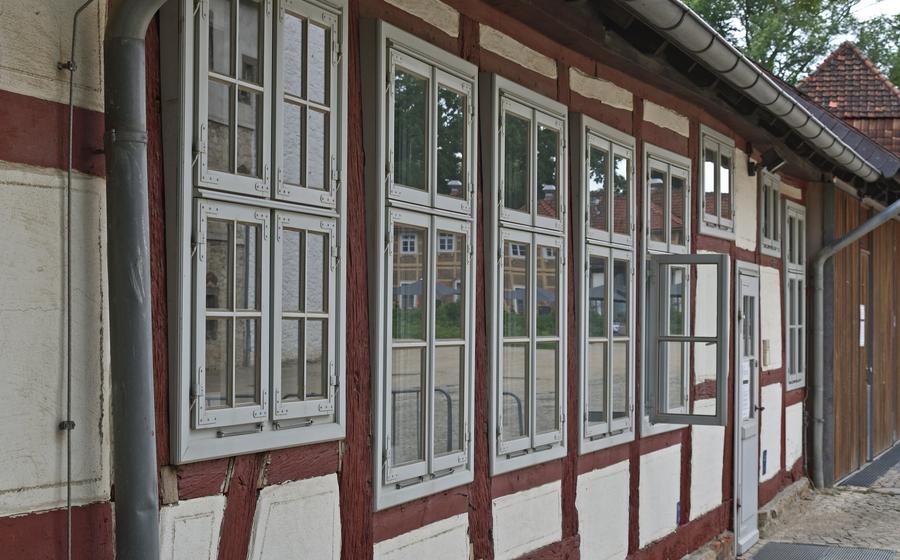
Wendschott Village Museum
- Brief History of Wolfsburg and Wendschott Village Museum
- Transportation and Accessibility
- Museum Highlights
- Traditional Architecture
- Farming and Agriculture
- Village Crafts
- Local Culture and Customs
- Interactive Experiences
- Seasonal Events
- Guided Tours
- Souvenir Shop
- Nearby Attractions
- Admission and Timings
- Food and Refreshments
- Insider Tip
Brief History of Wolfsburg and Wendschott Village Museum
Wolfsburg, a city in Lower Saxony, Germany, is renowned for its automotive industry and cultural heritage. Nestled within this vibrant city is the Wendschott Village Museum, a treasure trove of local history and traditions. The museum's origins can be traced back to the 1970s when a group of passionate individuals, driven by a desire to preserve the rich cultural legacy of the region, embarked on a mission to establish a museum dedicated to the history of Wendschott, a village incorporated into Wolfsburg in 197
Through meticulous research, the founders gathered artifacts, tools, and documents that showcased the daily lives, customs, and traditions of Wendschott's inhabitants. These precious items formed the foundation of the museum's collection, which has since grown to encompass over 15,000 exhibits, providing visitors with an immersive journey into the past. The Wendschott Village Museum stands as a testament to the enduring spirit of the local community and its unwavering commitment to preserving its cultural heritage.
Transportation and Accessibility
Reaching Wendschott Village Museum from Wolfsburg is a breeze. Whether you prefer the convenience of public transport or the freedom of driving your own car, there are several options to choose from.
For those relying on public transport, the regional bus network offers a direct route from Wolfsburg's central station to Wendschott village. Buses depart regularly, ensuring a hassle-free journey. Simply hop on the bus and enjoy the scenic countryside views as you make your way to the museum.
If you prefer the flexibility of driving, Wendschott Village Museum is easily accessible by car. Take the A39 motorway and follow the signs to Wendschott. Ample free parking is available on-site, so you can leave your car and immerse yourself in the charm of the village museum without any worries.
Museum Highlights
Amongst the various exhibits and attractions that await visitors at the Wendschott Village Museum, several key highlights stand out. One of the most captivating displays is the meticulously recreated village schoolhouse, complete with original furnishings and teaching materials. Here, visitors can step back in time and experience the educational environment of a bygone era.
Another must-see attraction is the blacksmith's forge, where skilled artisans demonstrate traditional metalworking techniques. The rhythmic clang of hammers against anvils fills the air as visitors watch these craftsmen create intricate pieces of ironwork, showcasing the mastery of a time-honored craft.
For those interested in agricultural history, the museum's farming exhibits offer a fascinating glimpse into the tools and practices of yesteryear. From antique tractors and plows to hand-operated harvesting equipment, these displays provide a tangible connection to the agrarian roots of the region.
Unique to the Wendschott Village Museum is its collection of historical costumes. These beautifully preserved garments showcase the traditional attire worn by villagers throughout the centuries, reflecting the changing fashions and social customs of the era. Visitors can admire the intricate embroidery, delicate fabrics, and unique styles that defined the local dress code.
These highlights, combined with numerous other exhibits and displays, create a comprehensive and immersive experience that brings the history and culture of Wendschott to life. Visitors of all ages will find something to captivate their attention and transport them back in time.
Traditional Architecture
Among the highlights of the Wendschott Village Museum are the carefully preserved examples of traditional German architecture. Visitors can wander through the cobblestone streets and admire the charming half-timbered houses, each with its unique character and story to tell. These buildings showcase the skill and craftsmanship of past generations, using local materials and construction techniques that have stood the test of time.
The museum's collection includes a variety of domestic and agricultural structures, providing a glimpse into the daily lives of Wendschott's former inhabitants. From the cozy living quarters to the barns and workshops, each building offers insights into the functionality and aesthetics of traditional German architecture. Visitors can appreciate the intricate carvings and decorative elements that adorn the facades, reflecting the pride and artistry of the builders.
The museum's commitment to authenticity extends to the use of traditional materials and methods in the restoration and preservation of the buildings. Visitors can learn about the different types of wood, clay, and thatch used in construction, as well as the techniques employed to create sturdy and weather-resistant structures. This attention to detail ensures that the museum remains a living testament to the rich architectural heritage of the region.
Farming and Agriculture
Farming has been an integral part of Wendschott's history and development. The museum features exhibits that showcase the traditional farming practices, tools, and techniques used by the village's residents. Visitors can explore displays of old-fashioned plows, harrows, and other implements, gaining insights into the physical labor and skill required to work the land. Interactive exhibits allow visitors to try their hand at grinding grain using a hand mill or churning butter using a traditional butter churn.
The museum also highlights the importance of agriculture in the village's self-sufficiency. Visitors can learn about the different crops that were grown, such as rye, wheat, and potatoes, and how they were used to feed the community. Displays on animal husbandry showcase the breeds of livestock that were raised, such as cows, pigs, and chickens, and their role in providing food, milk, and other products. These exhibits provide a glimpse into the challenges and rewards of farming life in Wendschott and the vital role it played in the village's survival and prosperity.
Village Crafts
Amongst the various exhibits at the Wendschott Village Museum, the displays of traditional crafts hold a special place. These exhibits showcase the skills and techniques that were once essential for the survival and prosperity of the village. Visitors can marvel at the intricately painted pottery, the finely woven textiles, and the beautifully crafted wooden objects that were produced by local artisans.
Pottery, in particular, played a significant role in the village's economy. The museum houses a remarkable collection of ceramic ware, including functional items like jugs, bowls, and plates, as well as decorative pieces such as vases and figurines. The vibrant colors and intricate patterns on these ceramics reflect the creativity and artistry of the local potters.
Weaving was another important craft in Wendschott. The museum's textile exhibits showcase a wide range of fabrics, from simple linens to elaborate tapestries. Visitors can learn about the different techniques used for spinning, weaving, and dyeing, and admire the intricate designs and patterns that were created by the village's weavers.
Woodworking was also an essential craft in the village, and the museum displays a variety of wooden objects, including furniture, tools, and toys. These objects showcase the skill and craftsmanship of the local woodworkers, who used their knowledge of wood properties and joinery techniques to create both functional and beautiful items.
The Wendschott Village Museum's collection of traditional crafts provides visitors with a glimpse into the ingenuity and resourcefulness of the village's inhabitants. These exhibits not only showcase the skills and techniques that were essential for the village's survival but also highlight the cultural heritage and traditions that have been passed down through generations.
Local Culture and Customs
The Wendschott Village Museum offers a glimpse into the rich cultural heritage of the region. Visitors can immerse themselves in the daily lives, traditions, and customs of Wendschott villagers, gaining insights into their unique way of life. The museum showcases various aspects of local culture, including traditional festivals, music, dance, and storytelling. Interactive exhibits allow visitors to experience firsthand the challenges and joys of rural life in the past. The museum also highlights the importance of community and cooperation, showcasing how the villagers worked together to build and maintain their village. By preserving and showcasing these cultural traditions, the museum plays a vital role in promoting and perpetuating the cultural heritage of Wendschott and the surrounding region.
Interactive Experiences
The Wendschott Village Museum offers a range of interactive experiences that allow visitors to engage with the museum's exhibits and learn about the village's history and culture in a hands-on way. These experiences include:
-
Workshops: The museum offers regular workshops where visitors can learn traditional crafts such as pottery, weaving, and woodworking. These workshops are led by experienced artisans who share their knowledge and skills with participants.
-
Demonstrations: Throughout the year, the museum hosts demonstrations of traditional farming practices, such as plowing, harvesting, and threshing. These demonstrations provide visitors with a glimpse into the daily lives of Wendschott villagers in the past.
-
Educational Programs: The museum offers educational programs for school groups and families. These programs include guided tours, hands-on activities, and interactive exhibits that teach children about the history and culture of Wendschott.
These interactive experiences make the Wendschott Village Museum a great place to visit for people of all ages. Whether you're interested in learning about traditional crafts, farming practices, or the history of the village, you're sure to find something to enjoy at the museum.
Seasonal Events
The Wendschott Village Museum comes alive during seasonal events and festivals, providing visitors with a glimpse into the vibrant traditions and culture of the region. Throughout the year, the museum hosts various events that celebrate local customs and showcase the region's rich heritage.
One of the highlights is the annual Wendschott Village Festival, held during the summer months. This lively event features traditional music and dance performances, craft demonstrations, and a variety of food stalls serving local delicacies. Visitors can experience the charm of the village as it transforms into a bustling marketplace, filled with the sounds, sights, and aromas of the past.
Another popular event is the Christmas Market, held during the festive season. The museum grounds are adorned with twinkling lights and festive decorations, creating a magical atmosphere. Visitors can browse stalls selling handmade crafts, ornaments, and local produce, while enjoying mulled wine and traditional Christmas treats.
These seasonal events offer a unique opportunity to immerse oneself in the local culture and traditions of Wendschott. By participating in these festivities, visitors can gain a deeper appreciation for the region's rich heritage and the way of life that has been preserved for generations.
Guided Tours
The Wendschott Village Museum offers guided tours in German and English, led by knowledgeable and enthusiastic guides who bring the museum's exhibits to life. These tours provide an in-depth understanding of the history, culture, and traditions of Wendschott. Visitors can learn about the daily lives of villagers, the challenges they faced, and the unique customs that shaped their community.
Exploring the museum with a guide offers several advantages. Guides can provide historical context and anecdotes that bring the exhibits to life, helping visitors to connect with the past on a deeper level. They can also point out hidden details and lesser-known stories that might otherwise go unnoticed. Guided tours are an excellent option for groups, families, or individuals who want to make the most of their visit and gain a comprehensive understanding of the museum's treasures.
Guided tours are available at specific times throughout the day and can be booked in advance or on the day of your visit. Be sure to inquire about the availability of tours in your preferred language when planning your visit. Whether you're a history buff, a culture enthusiast, or simply curious to learn more about the Wendschott Village Museum, a guided tour is an enriching and rewarding experience that will enhance your understanding and appreciation of this unique museum.
Souvenir Shop
As you make your way through the museum, be sure to stop by the quaint souvenir shop, where you can find a treasure trove of unique mementos and local handicrafts to take home. From traditional pottery and intricately woven textiles to handcrafted wooden items, each piece is a testament to the skill and artistry of the local artisans.
By purchasing a souvenir from the museum shop, you not only take a piece of Wendschott's heritage home with you, but you also contribute to the preservation of these valuable crafts and support the livelihoods of local artisans. Whether it's a delicate ceramic ornament, a cozy hand-knit scarf, or a beautifully carved wooden figurine, every item is carefully selected to represent the unique charm and traditions of Wendschott.
So, as you browse the shelves and admire the craftsmanship on display, take the opportunity to support local talent and bring a piece of Wendschott's rich cultural heritage back home with you.
Nearby Attractions
Wendschott Village Museum is situated in a region rich in historical and cultural attractions. After exploring the museum, visitors can extend their itinerary to discover other nearby destinations.
-
Wolfsburg Castle: Just a short drive from the museum, Wolfsburg Castle stands as a testament to the region's rich history. Built in the 13th century, the castle offers guided tours that provide insights into medieval life and architecture.
-
Autostadt: For car enthusiasts, Autostadt is a must-visit destination. Located in Wolfsburg, it is a unique theme park dedicated to the world of automobiles. Visitors can explore interactive exhibits, admire classic and modern cars, and even take a test drive on a Volkswagen track.
-
Phaeno Science Center: A short drive from Wolfsburg, Phaeno Science Center is a hands-on science museum that offers a fun and educational experience for visitors of all ages. With over 350 interactive exhibits, Phaeno encourages visitors to explore the wonders of science through experimentation and play.
-
Gifhorn Castle: Located in the nearby town of Gifhorn, Gifhorn Castle is another architectural gem worth visiting. Built in the 16th century, the castle is surrounded by a beautiful park and offers guided tours that showcase its impressive Renaissance architecture and historical significance.
-
Allerpark: For those seeking outdoor recreation, Allerpark is a sprawling park located along the Aller River. Visitors can enjoy scenic walks, bike rides, or boat tours, and explore the park's many attractions, including a miniature golf course, a climbing garden, and a water playground.
Admission and Timings
The Wendschott Village Museum welcomes visitors of all ages to explore its rich collection and immerse themselves in the history and traditions of the region. To ensure a smooth and enjoyable experience, it's essential to plan your visit carefully.
Admission Fees: - Adults: 5 Euros - Children (6-14 years): 3 Euros - Family Ticket (2 adults and 2 children): 10 Euros
Operating Hours: - Summer Season (April to October): - Tuesday to Sunday: 10 AM to 5 PM - Winter Season (November to March): - Tuesday to Sunday: 11 AM to 4 PM
The museum remains closed on Mondays throughout the year. To avoid any disappointment, it's advisable to check the museum's official website or contact them directly for any updates or special events.
Planning Your Visit: - Peak Season (July and August): Expect larger crowds during the summer months. Advance planning is recommended, especially if you're visiting with a group. - Off-Peak Season (November to February): Enjoy a more relaxed and intimate experience during the winter months. This is an excellent time for photography enthusiasts and those seeking a tranquil atmosphere.
Food and Refreshments
The Wendschott Village Museum offers a delightful culinary experience for visitors, allowing them to savor the flavors of traditional German cuisine. Within the museum's premises, visitors can find a charming café that serves a variety of refreshments, including freshly brewed coffee, tea, and homemade pastries. For those seeking a more substantial meal, the café also offers a selection of traditional German dishes, such as hearty soups, freshly baked bread, and regional specialties.
While enjoying their meal, visitors can soak in the charming ambiance of the café, which is decorated with traditional German artifacts and offers stunning views of the surrounding countryside. Whether it's a quick bite or a leisurely lunch, the café at the Wendschott Village Museum provides a perfect opportunity to relax, refuel, and immerse oneself in the local culinary culture.
Insider Tip:
For a truly authentic experience, be sure to try the museum's signature dish, the "Wendschotter Kartoffelpuffer" (potato pancakes), served with traditional accompaniments like apple sauce and sour cream.
Insider Tip
As you wander through the Wendschott Village Museum, keep an eye out for the hidden gem tucked away in the back corner of the courtyard. Here, you'll find the village's old blacksmith shop, where generations of skilled craftsmen once forged tools and crafted ironworks. The forge still stands as a testament to the village's rich history of metalworking, and visitors are welcome to step inside and learn about the blacksmith's trade. Don't miss this unique opportunity to experience the magic of traditional craftsmanship firsthand.
